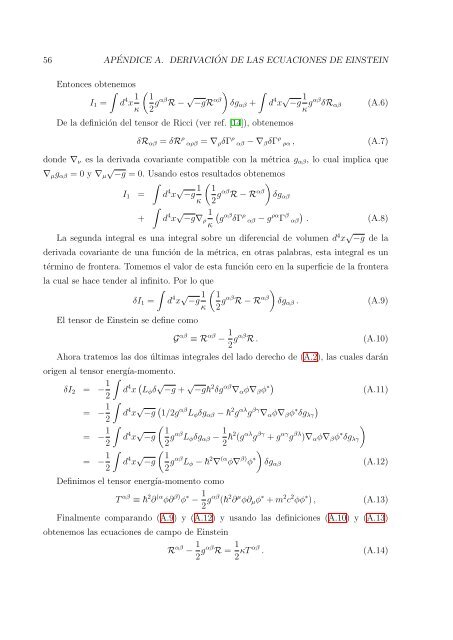Formacion de estructura con campos escalares: la ... - Cinvestav
Formacion de estructura con campos escalares: la ... - Cinvestav
Formacion de estructura con campos escalares: la ... - Cinvestav
- No tags were found...
You also want an ePaper? Increase the reach of your titles
YUMPU automatically turns print PDFs into web optimized ePapers that Google loves.
56APÉNDICE A. DERIVACIÓN DE LAS ECUACIONES DE EINSTEINEntonces obtenemos∫I 1 = d 4 x 1 κ( 12 gαβ R − √ ) ∫−gR αβ δg αβ +d 4 x √ −g 1 κ gαβ δR αβ(A.6)De <strong>la</strong> <strong>de</strong>finición <strong>de</strong>l tensor <strong>de</strong> Ricci (ver ref. [14]), obtenemosδR αβ = δR ρ αρβ = ∇ ρ δΓ ρ αβ − ∇ β δΓ ρ ρα ,(A.7)don<strong>de</strong> ∇ ν es <strong>la</strong> <strong>de</strong>rivada covariante compatible <strong>con</strong> <strong>la</strong> métrica g αβ , lo cual implica que√∇ µ g αβ = 0 y ∇ µ −g = 0. Usando estos resultados obtenemos∫I 1 = d 4 x √ −g 1 ( )1κ 2 gαβ R − R αβ δg αβ∫+ d 4 x √ 1 ( )−g∇ ρ g αβ δΓ ρ αβ − g ρα Γ β αβ . (A.8)κLa segunda integral es una integral sobre un diferencial <strong>de</strong> volumen d 4 x √ −g <strong>de</strong> <strong>la</strong><strong>de</strong>rivada covariante <strong>de</strong> una función <strong>de</strong> <strong>la</strong> métrica, en otras pa<strong>la</strong>bras, esta integral es untérmino <strong>de</strong> frontera. Tomemos el valor <strong>de</strong> esta función cero en <strong>la</strong> superficie <strong>de</strong> <strong>la</strong> frontera<strong>la</strong> cual se hace ten<strong>de</strong>r al infinito. Por lo que∫δI 1 = d 4 x √ −g 1 ( )1κ 2 gαβ R − R αβ δg αβ .El tensor <strong>de</strong> Einstein se <strong>de</strong>fine como(A.9)G αβ ≡ R αβ − 1 2 gαβ R .(A.10)Ahora tratemos <strong>la</strong>s dos últimas integrales <strong>de</strong>l <strong>la</strong>do <strong>de</strong>recho <strong>de</strong> (A.2), <strong>la</strong>s cuales daránorigen al tensor energía-momento.δI 2 = − 1 ∫d 4 x ( L φ δ √ −g + √ −g 2 δg αβ ∇ α φ∇ β φ ∗)(A.11)2= − 1 ∫d 4 x √ −g ( )1/2g αβ L φ δg αβ − 2 g αλ g βγ ∇ α φ∇ β φ ∗ δg λγ2= − 1 ∫d 4 x √ ( 1−g22 gαβ L φ δg αβ − 1 )2 2 (g αλ g βγ + g αγ g βλ )∇ α φ∇ β φ ∗ δg λγ= − 1 ∫d 4 x √ ( )1−g22 gαβ L φ − 2 ∇ (α φ∇ β) φ ∗ δg αβ(A.12)Definimos el tensor energía-momento comoT αβ ≡ 2 ∂ (α φ∂ β) φ ∗ − 1 2 gαβ ( 2 ∂ µ φ∂ µ φ ∗ + m 2 c 2 φφ ∗ ) ,(A.13)Finalmente comparando (A.9) y (A.12) y usando <strong>la</strong>s <strong>de</strong>finiciones (A.10) y (A.13)obtenemos <strong>la</strong>s ecuaciones <strong>de</strong> campo <strong>de</strong> EinsteinR αβ − 1 2 gαβ R = 1 2 κT αβ .(A.14)
















